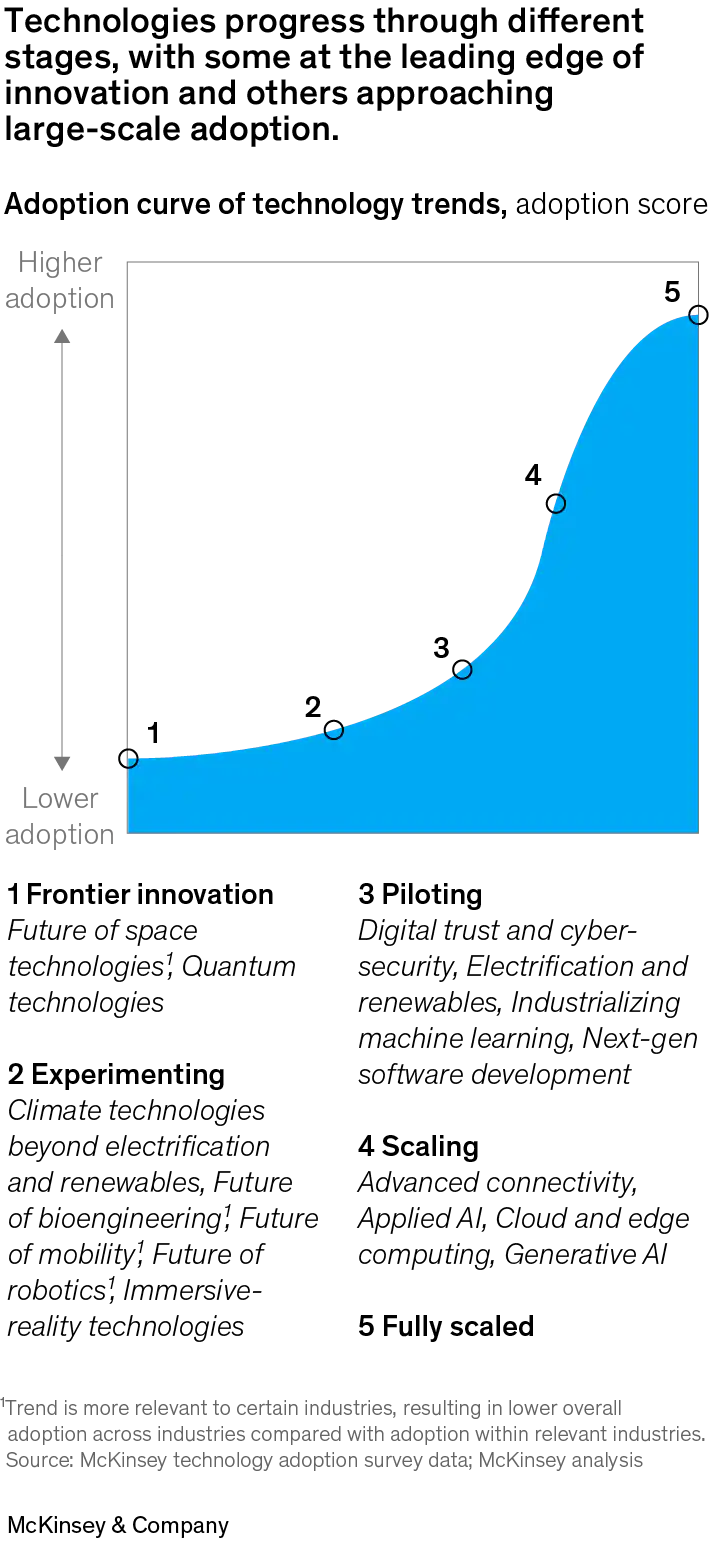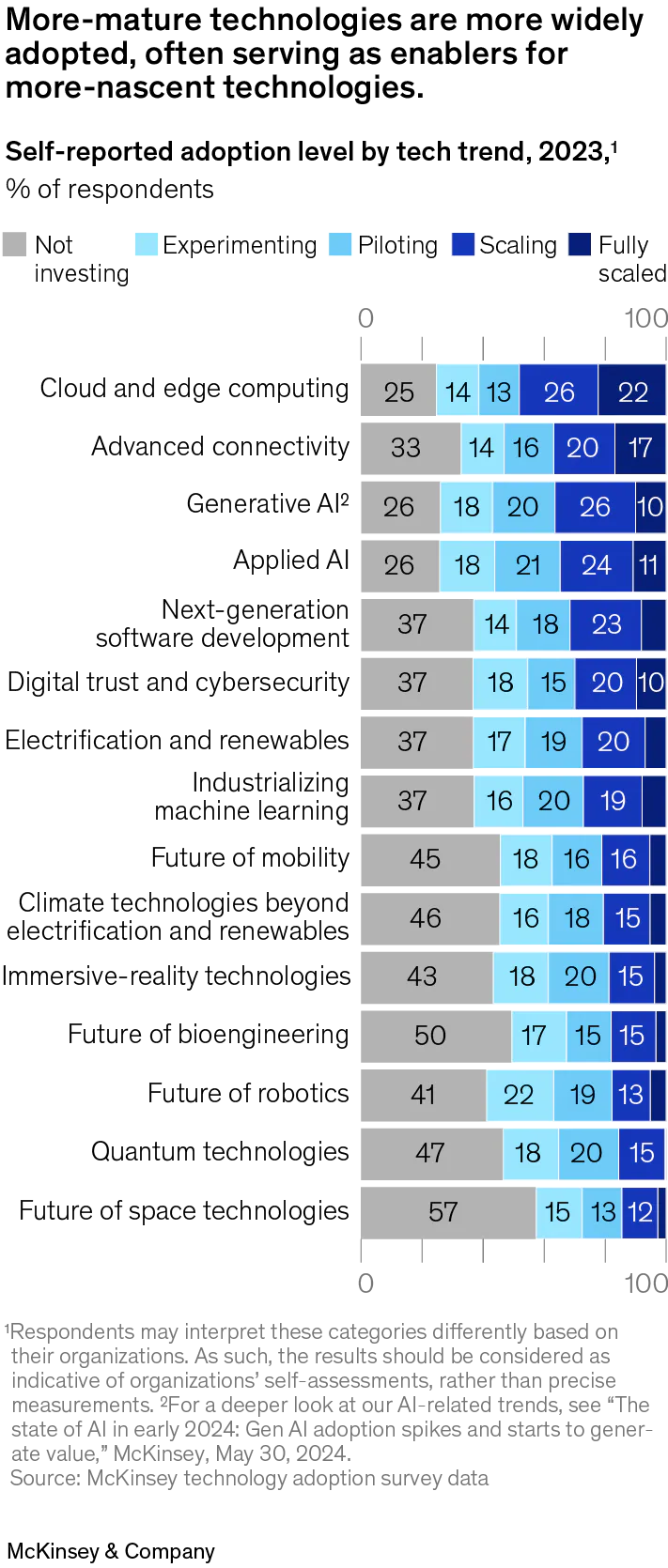- 1: Frontier innovation. This technology is still nascent, with few organizations investing in or applying it. It is largely untested and unproven in a business context.
- 2: Experimentation. Organizations are testing the functionality and viability of the technology with a small-scale prototype, typically done without a strong focus on a near-term ROI. Few companies are scaling or have fully scaled the technology.
- 3: Piloting. Organizations are implementing the technology for the first few business use cases. It may be used in pilot projects or limited deployments to test its feasibility and effectiveness.
- 4: Scaling. Organizations are in the process of scaling the deployment and adoption of the technology across the enterprise. The technology is being scaled by a significant number of companies.
- 5: Fully scaled. Organizations have fully deployed and integrated the technology across the enterprise. It has become the standard and is being used at a large scale as companies have recognized the value and benefits of the technology.
Electrification and renewables was the other trend that bucked the economic headwinds, posting the highest investment and interest scores among all the trends we evaluated. Job postings for this sector also showed a modest increase.
Although many trends faced declines in investment and hiring in 2023, the long-term outlook remains positive. This optimism is supported by the continued longer-term growth in job postings for the analyzed trends (up 8 percent from 2021 to 2023) and enterprises’ continued innovation and heightened interest in harnessing these technologies, particularly for future growth.
In 2023, technology equity investments fell by 30 to 40 percent to approximately $570 billion due to rising financing costs and a cautious near-term growth outlook, prompting investors to favor technologies with strong revenue and margin potential. This approach aligns with the strategic perspective leading companies are adopting, in which they recognize that fully adopting and scaling cutting-edge technologies is a long-term endeavor. This recognition is evident when companies diversify their investments across a portfolio of several technologies, selectively intensifying their focus on areas most likely to push technological boundaries forward. While many technologies have maintained cautious investment profiles over the past year, gen AI saw a sevenfold increase in investments, driven by substantial advancements in text, image, and video generation.
About QuantumBlack, AI by McKinseyQuantumBlack, McKinsey’s AI arm, helps companies transform using the power of technology, technical expertise, and industry experts. With thousands of practitioners at QuantumBlack (data engineers, data scientists, product managers, designers, and software engineers) and McKinsey (industry and domain experts), we are working to solve the world’s most important AI challenges. QuantumBlack Labs is our center of technology development and client innovation, which has been driving cutting-edge advancements and developments in AI through locations across the globe.
Despite an overall downturn in private equity investment, the pace of innovation has not slowed. Innovation has accelerated in the three trends that are part of the “AI revolution” group: gen AI, applied AI, and industrializing machine learning. Gen AI creates new content from unstructured data (such as text and images), applied AI leverages machine learning models for analytical and predictive tasks, and industrializing machine learning accelerates and derisks the development of machine learning solutions. Applied AI and industrializing machine learning, boosted by the widening interest in gen AI, have seen the most significant uptick in innovation, reflected in the surge in publications and patents from 2022 to 2023. Meanwhile, electrification and renewable-energy technologies continue to capture high interest, reflected in news mentions and web searches. Their popularity is fueled by a surge in global renewable capacity, their crucial roles in global decarbonization efforts, and heightened energy security needs amid geopolitical tensions and energy crises.
The talent environment largely echoed the investment picture in tech trends in 2023. The technology sector faced significant layoffs, particularly among large technology companies, with job postings related to the tech trends we studied declining by 26 percent—a steeper drop than the 17 percent decrease in global job postings overall. The greater decline in demand for tech-trends-related talent may have been fueled by technology companies’ cost reduction efforts amid decreasing revenue growth projections. Despite this reduction, the trends with robust investment and innovation, such as gen AI, not only maintained but also increased their job postings, reflecting a strong demand for new and advanced skills. Electrification and renewables was the other trend that saw positive job growth, partially due to public sector support for infrastructure spending.
Even with the short-term vicissitudes in talent demand, our analysis of 4.3 million job postings across our 15 tech trends underscored a wide skills gap. Compared with the global average, fewer than half the number of potential candidates have the high-demand tech skills specified in job postings. Despite the year-on-year decreases for job postings in many trends from 2022 to 2023, the number of tech-related job postings in 2023 still represented an 8 percent increase from 2021, suggesting the potential for longer-term growth (Exhibit 1).
Enterprise technology adoption momentum
The trajectory of enterprise technology adoption is often described as an S-curve that traces the following pattern: technical innovation and exploration, experimenting with the technology, initial pilots in the business, scaling the impact throughout the business, and eventual fully scaled adoption (Exhibit 2). This pattern is evident in this year’s survey analysis of enterprise adoption conducted across our 15 technologies. Adoption levels vary across different industries and company sizes, as does the perceived progress toward adoption.

A graph depicts the adoption curve of technology trends, scored from 1 to 5, where 1 represents frontier innovation, located at the bottom left corner of the curve; 2 is experimenting, located slightly above frontier innovation; 3 is piloting, which follows the upward trajectory of the curve; 4 is scaling, marked by a vertical ascent as adoption increases; and 5 is fully scaled, positioned at the top of the curve, indicating near-complete adoption.
In 2023, the trends are positioned along the adoption curve as follows: future of space technologies and quantum technologies are at the frontier innovation stage; climate technologies beyond electrification and renewables, future of bioengineering, future of mobility, future of robotics, and immersive-reality technologies are at the experimenting stage; digital trust and cybersecurity, electrification and renewables, industrializing machine learning, and next-gen software development are at the piloting stage; and advanced connectivity, applied AI, cloud and edge computing, and generative AI are at the scaling stage.
Footnote: Trend is more relevant to certain industries, resulting in lower overall adoption across industries compared with adoption within relevant industries.
Source: McKinsey technology adoption survey data
End of image description.
We see that the technologies in the S-curve’s early stages of innovation and experimenting are either on the leading edge of progress, such as quantum technologies and robotics, or are more relevant to a specific set of industries, such as bioengineering and space. Factors that could affect the adoption of these technologies include high costs, specialized applications, and balancing the breadth of technology investments against focusing on a select few that may offer substantial first-mover advantages.
As technologies gain traction and move beyond experimenting, adoption rates start accelerating, and companies invest more in piloting and scaling. We see this shift in a number of trends, such as next-generation software development and electrification. Gen AI’s rapid advancement leads among trends analyzed, about a quarter of respondents self-reporting that they are scaling its use. More mature technologies, like cloud and edge computing and advanced connectivity, continued their rapid pace of adoption, serving as enablers for the adoption of other emerging technologies as well (Exhibit 3).

A segmented bar graph shows the adoption levels of tech trends in 2023 as a percentage of respondents. The trends are divided into 5 segments, comprising 100%: fully scaled, scaling, piloting, experimenting, and not investing. The trends are arranged based on the combined percentage sum of fully scaled and scaling shares. Listed from highest to lowest, these combined percentages are as follows:
- cloud and edge computing at 48%
- advanced connectivity at 37%
- generative AI at 36%
- applied AI at 35%
- next-generation software development at 31%
- digital trust and cybersecurity at 30%
- electrification and renewables at 28%
- industrializing machine learning at 27%
- future of mobility at 21%
- climate technologies beyond electrification and renewables at 20%
- immersive-reality technologies at 19%
- future of bioengineering at 18%
- future of robotics at 18%
- quantum technologies at 15%
- future of space technologies at 15%
Source: McKinsey technology adoption survey data
End of image description.
The process of scaling technology adoption also requires a conducive external ecosystem where user trust and readiness, business model economics, regulatory environments, and talent availability play crucial roles. Since these ecosystem factors vary by geography and industry, we see different adoption scenarios playing out. For instance, while the leading banks in Latin America are on par with their North American counterparts in deploying gen AI use cases, the adoption of robotics in manufacturing sectors varies significantly due to differing labor costs affecting the business case for automation.
As executives navigate these complexities, they should align their long-term technology adoption strategies with both their internal capacities and the external ecosystem conditions to ensure the successful integration of new technologies into their business models. Executives should monitor ecosystem conditions that can affect their prioritized use cases to make decisions about the appropriate investment levels while navigating uncertainties and budgetary constraints on the way to full adoption (see the “Adoption developments across the globe” sections within each trend or particular use cases therein that executives should monitor). Across the board, leaders who take a long-term view—building up their talent, testing and learning where impact can be found, and reimagining the businesses for the future—can potentially break out ahead of the pack.
Lareina Yee is a senior partner in McKinsey’s Bay Area office, where Michael Chui is a McKinsey Global Institute partner, Roger Roberts is a partner, and Mena Issler is an associate partner.
The authors wish to thank the following McKinsey colleagues for their contributions to this research: Aakanksha Srinivasan, Ahsan Saeed, Alex Arutyunyants, Alex Singla, Alex Zhang, Alizee Acket-Goemaere, An Yan, Anass Bensrhir, Andrea Del Miglio, Andreas Breiter, Ani Kelkar, Anna Massey, Anna Orthofer, Arjit Mehta, Arjita Bhan, Asaf Somekh, Begum Ortaoglu, Benjamin Braverman, Bharat Bahl, Bharath Aiyer, Bhargs Srivathsan, Brian Constantine, Brooke Stokes, Bryan Richardson, Carlo Giovine, Celine Crenshaw, Daniel Herde, Daniel Wallance, David Harvey, Delphine Zurkiya, Diego Hernandez Diaz, Douglas Merrill, Elisa Becker-Foss, Emma Parry, Eric Hazan, Erika Stanzl, Everett Santana, Giacomo Gatto, Grace W Chen, Hamza Khan, Harshit Jain, Helen Wu, Henning Soller, Ian de Bode, Jackson Pentz, Jeffrey Caso, Jesse Klempner, Jim Boehm, Joshua Katz, Julia Perry, Julian Sevillano, Justin Greis, Kersten Heineke, Kitti Lakner, Kristen Jennings, Liz Grennan, Luke Thomas, Maria Pogosyan, Mark Patel, Martin Harrysson, Martin Wrulich, Martina Gschwendtner, Massimo Mazza, Matej Macak, Matt Higginson, Matt Linderman, Matteo Cutrera, Mellen Masea, Michiel Nivard, Mike Westover, Musa Bilal, Nicolas Bellemans, Noah Furlonge-Walker, Obi Ezekoye, Paolo Spranzi, Pepe Cafferata, Robin Riedel, Ryan Brukardt, Samuel Musmanno, Santiago Comella-Dorda, Sebastian Mayer, Shakeel Kalidas, Sharmila Bhide, Stephen Xu, Tanmay Bhatnagar, Thomas Hundertmark, Tinan Goli, Tom Brennan, Tom Levin-Reid, Tony Hansen, Vinayak HV, Yaron Haviv, Yvonne Ferrier, and Zina Cole.
They also wish to thank the external members of the McKinsey Technology Council for their insights and perspectives, including Ajay Agrawal, Azeem Azhar, Ben Lorica, Benedict Evans, John Martinis, and Jordan Jacobs.
Special thanks to McKinsey Global Publishing colleagues Barr Seitz, Diane Rice, Kanika Punwani, Katie Shearer, LaShon Malone, Mary Gayen, Nayomi Chibana, Richard Johnson, Stephen Landau, and Victor Cuevas for making this interactive come alive.